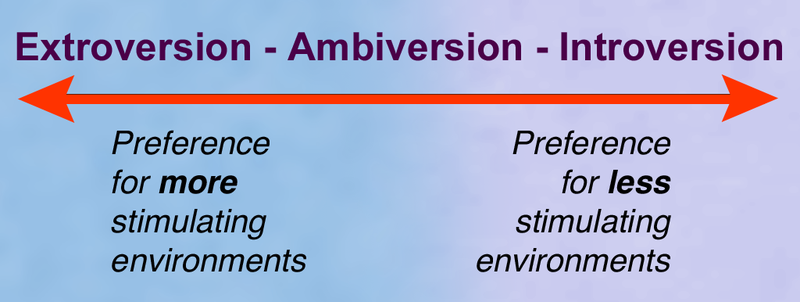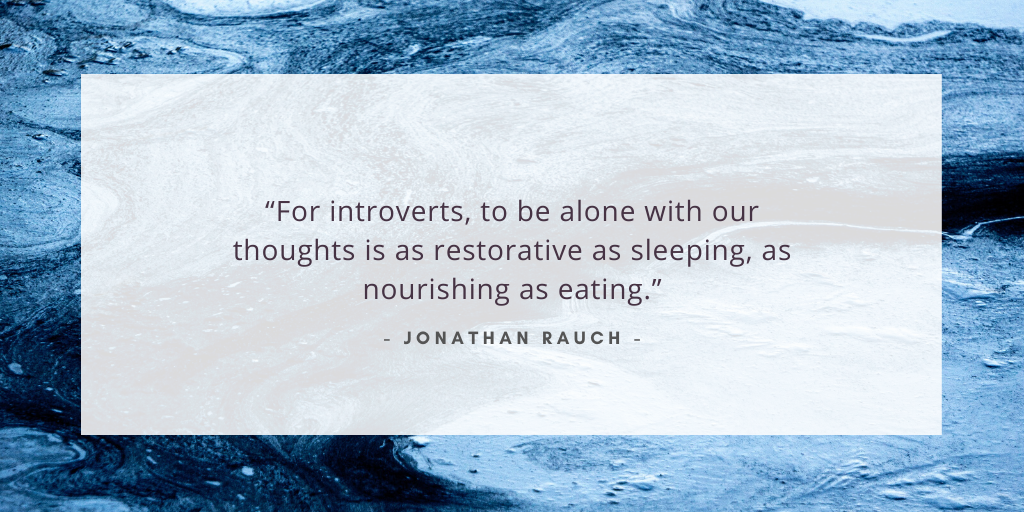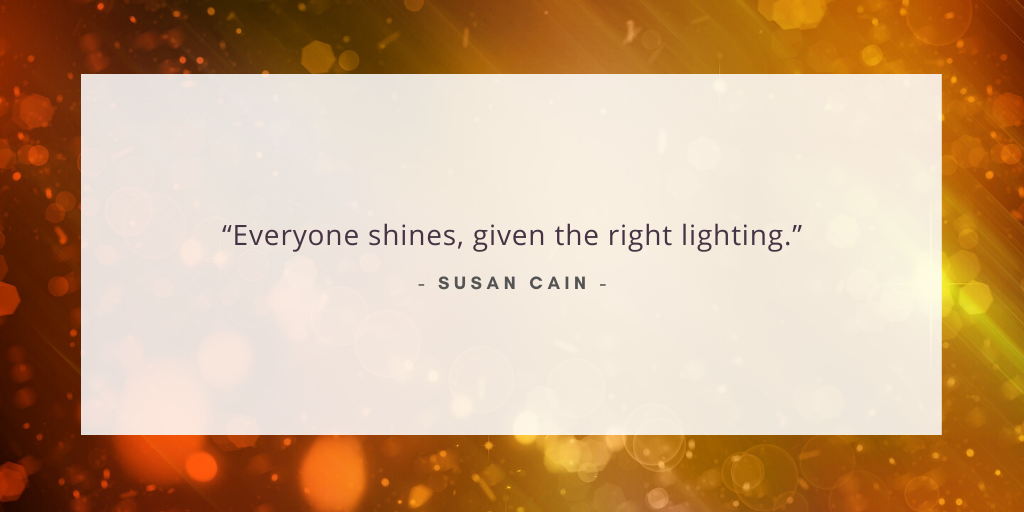When designing programs, it’s all too easy to assume that all students desire robust external stimulation, can’t get enough social time, and adore chatting the day away.
In other words, our programs are often made for extroverts.
But what about the introverts? You’d be wrong to think that being introverted is equivalent to being shy, having social anxiety, and/or lacking any interest in other people. No need to envision your introverts students cloaked in all black, emerging from the depths of their quiet rooms exclusively for class, and only talking when absolutely necessary.
They can – and very often do — enjoy socializing and deeply value interpersonal relationships. It’s just that they prefer different modes of socializing, ones with less stimulation.
See, the scale of introversion and extroversion is all about energy and stimulation.

Extroverts gain energy while in high-stimulation environments (like most typical campus programs) and introverts lose energy from such surroundings. They greatly value alone time and quieter activities; they need it to recharge and feel their best.
So, no, your introverted students aren’t deadset against your professional mission to engage them in campus life. But, in order to engage introverts, we need to craft programs and offer initiatives that may seem atypical to our usual offerings.
Here are some ideas for doing so, courtesy of one proud introvert. (That’s me!)
7 Tips
1. Don’t use introvert as a bad word, even around each other
First off, get the idea out of your head that extroverts are the good students (the ideal happy, bubbly, easy-to-engage individuals) and that the introverts are the bad, downtrodden and difficult-to-engage ones. That’s simply untrue.
Introverts are often extremely trustworthy, hardworking, observant, emotionally intelligent, and self-sufficient. In other words, they have many of the wonderful qualities we hope to foster in students. They don’t deserve a bias against them.
But unfortunately, many societal systems, including education, favor extroverts. You don’t need to contribute to this. Never wield the word “introvert” as an insult nor imply that it should have a negative connotation. Students easily pick up on those things, and it sends the message that they are not valued and that campus life isn’t designed for them.
I also recommend avoiding negative introvert-talk around your colleagues, even when students are far from earshot. Not only might such comments be disheartening to staff who are introverts themselves, but letting yourself speak like this can influence your own biases.
It can seep into your everyday behavior and attitudes. Perhaps most dangerously, it can lead you to disproportionately hire extroverted student staff and pros; it’s best to have a mix. Introverts can be incredible employees.
So, work toward seeing introverts as no less awesome as extroverts; they’re simply different. Let your language reflect this.
2. Forge one-on-one connections
Most introverts don’t like small talk. Or as one blogger put it, “It feels awkward, superficial, and unnecessary for us to chit chat about the weather or latest sporting event (unless we are actually passionate about those topics).”
However, introverts are typically pros at self-reflection and active listening. All of this means they value deep, meaningful connections.
So, although they might not be terribly infused about playing a name game or Two Truths and a Lie, introverts often appreciate opportunities to connect with peers in meaningful one-on-one ways. You can help facilitate such opportunities!
For example, consider setting students up with one-on-one lunch buddies. Ask students to fill out a survey indicating their personal interests and hobbies, and you’ll match them with a like-minded peer. You’ll then hold a special lunch wherein the pairings sit together. Or you could simply email them both so they can make lunch arrangements on their own.
And consider substituting surface-level icebreakers with something a bit deeper — at least occasionally. For example, you can mix up your series of five high-energy large-group icebreakers during orientation with one or two questions that require participants to quietly self-reflect or discuss a challenging issue with just one or two of their peers.
It would be especially valuable to create such one-on-one moments during large events. Rather than students wading into a strange room with dozens (or even hundreds) of their peers mingling about, consider pairing them off with just a few — even if it’s only at the start of the event. This could even be optional, with students electing to sign up for event buddies… or not.

3. Connect students with introverted student organizations
Know of an introverted student who is struggling to find their place within the campus community? Consider connecting them to student organizations that engage in introverted activities.
I’m thinking of clubs focused on reading, watching movies, knitting, visiting museums, seeing local theater, gardening, cooking, doing arts and crafts projects, or playing board games. Or, you could encourage a student to start an org of their very own! (Bonus points if you volunteer to serve as the group’s advisor… if you have the time.)
This way, students will have the familiar comfort of an activity they already enjoy, with the added bonus of making friends. The would-be solo activity becomes social! Participating won’t drain their energy as much as other orgs might because these activities involve less stimulation and naturally allow for some solo time.
4. Schedule in downtime during programs
You might think that having lulls doing programs will lead students to complain of boredom. And yes, some students might genuinely feel that way, but many will greatly appreciate getting a break from intense stimulation. In fact, introverts need breaks in order to feel and act their best the rest of the time.
Now, you don’t necessarily need to schedule empty time wherein students do absolutely nothing. No need to force everyone to stare blankly at each other, twiddling their thumbs and wondering what’s next.
Rather, you can include times for self-reflection, one-on-one discussions, journal writing, or even meditation — basically anything that gives participants a break from high-energy social interaction.
You could even make your breaks optional, allowing students a guilt-free pass from socializing for a bit, if they wish to take it.

5. Offer alternative roles in activities
Don’t mistake a student’s reluctance to join in on a higher-energy program for snobbery. They might simply find it uncomfortable or intimidating.
But that doesn’t mean they’re a lost cause for engagement! Consider offering them alternative roles that don’t require chatting with loads of people nor being the center of attention at any point.
For example, they could serve as a scorekeeper or timekeeper during a competition, take notes or write ideas up on a whiteboard during a discussion, or be the photographer or videographer for a performance.
I recommend telling students about these roles and asking for volunteers, rather than putting the onus on them to request such alternatives.
But remember: Introverted students may sometimes love to take part in higher-energy programs, depending on their mood and interest in the program’s focus. I, for example, am an introvert who will happily embrace the cheesiness of my favorite icebreakers. But for a high-pressure competition, I’d rather be a judge or scorekeeper; thanks very much.
So, don’t automatically relegate a student to one of these alternative roles. You don’t want them to feel singled out. Volunteering puts them in control.
6. Let them know what to expect
This tip will also benefit students with anxiety and processing difficulties. By letting students know ahead of time what to expect out of an event, they’ll be able to mentally prepare themselves.
For introverted students, this may mean conserving their energy before the most stimulating part of the program so that they can fully dive into socializing when the time comes.
You don’t necessarily need to inform students of every minuscule planned detail; instead, focus on the big things they’ll be doing. Be sure to also mention low-stimulation times, like bathroom breaks, meals, and opportunities for asking questions. Ideally, you should include not just the sequence of events but the times, too — or at least your best estimate.
You could communicate these details by handing out schedules to each participant, placing a copy or two on each table, or displaying it in large letters on an overheard board. I don’t recommend merely announcing the schedule at the start, as students will likely forget and keep asking you “what’s next?”
Better yet, you can give students the scoop before the event even begins — by emailing them the schedule, advertising it on fliers and social media, or including it in a mobile events app. Doing so might convince any students who are on-the-fence about attending to give it a shot!

7. Engage them on social media
You surely don’t want students to spend all of their time staring at their phones, laptops, and tablets, rather than interacting IRL.
But consider the power social media has to make students feel connected to your community. It could help ease them into interacting with their peers (and you!) before revving up their energies for a real-life program.
Students can communicate with each other, learn about campus happenings, and share their experiences online from the comfort of their own residence halls. They can build a virtual community that eventually expands to the real one.
Wouldn’t you, for example, rather have an introverted student spend 15 minutes chatting on Twitter with their peers than feeling lonely and disconnected?
See, introverted students might not often feel up to attending events, due to the high energy it’ll take out of them. Alone time feels much safer and alluring, especially after a long stressful day full of class, studying, and other responsibilities.
But social media allows them to straddle the line. They can enjoy their alone time in a familiar physical space while still learning from others and contributing to campus conversations.

By building educational systems solely for stereotypical extroverts, we do a large portion of students a major disservice. You probably can’t change worldwide cultural norms all on your own, but with a bit of creativity and patience, you at least have the power to improve the campus experience for your students.
How have you engaged introverted students? Let’s learn from each other! Tweet us @themoderncampus.





